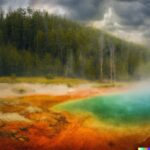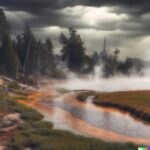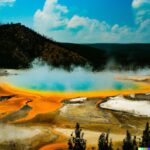Yellowstone National Park is home to some of the world’s most famous geysers, which hold immense cultural significance for Indigenous peoples. Traditional stories and beliefs surrounding these natural wonders have been passed down through generations, highlighting their importance in Indigenous communities.
The impact of tourism on Yellowstone geysers and Indigenous access raises concerns about environmental conservation and cultural preservation. Efforts are being made to protect these geysers and include Indigenous voices in conservation initiatives.
Looking ahead, the future of Yellowstone geysers and Indigenous perspectives on their preservation are crucial topics for discussion. Join us as we explore the history, cultural significance, and future of Yellowstone geysers through the lens of Indigenous peoples.
The History of Yellowstone Geysers
The history of Yellowstone Geysers is deeply intertwined with the geological wonders of the region, showcasing a legacy of geothermal activity that dates back centuries.
This remarkable area is home to some of the world’s most famous geysers, with Old Faithful being a prime example that draws visitors from far and wide. The unique formations of these geysers, such as the cone-shaped structures and colorful mineral deposits, offer a glimpse into the dynamic processes at play deep within the Earth’s crust.
The enduring presence of geothermal activity in Yellowstone National Park continues to shape the landscape, constantly transforming and reshaping the terrain over time.
The Cultural Significance of Yellowstone Geysers to Indigenous Peoples
The cultural significance of Yellowstone Geysers to Indigenous Peoples is profound, rooted in sacred traditions, ancestral teachings, and a deep spiritual connection to the natural wonders of the land.
These geothermal features hold not only physical beauty but also symbolic importance in the storytelling and oral histories passed down through generations.
For many Indigenous communities, the geysers are seen as living beings, embodying spirits and energies that connect them to their ancestors and the Earth itself.
The traditional knowledge surrounding these natural phenomena guides rituals, ceremonies, and cultural practices, reinforcing the intricate bond between Indigenous Peoples and the land they have stewarded for centuries.
What Are the Traditional Stories and Beliefs Surrounding Yellowstone Geysers?
The traditional stories and beliefs surrounding Yellowstone Geysers are steeped in Native American beliefs, passed down through generations via rich storytelling traditions and sacred ceremonies.
These narratives weave together the natural wonders of the geysers with profound spiritual connections that the Native American communities have maintained for centuries. Within these folklore tales, the geysers are often portrayed as powerful beings with their own spirits, embodying the Earth’s energy and serving as manifestations of the intricate relationship between humankind and nature. The ceremonial rituals associated with the geysers are not just events; they are sacred expressions of gratitude, propitiation, and harmony with the land. Through these traditions, ancient wisdom and spiritual insights are imparted, fostering a deep respect for the interconnectedness of all living things.
How Were Yellowstone Geysers Used by Indigenous Peoples?
Yellowstone Geysers were utilized by Indigenous Peoples in accordance with tribal traditions and environmentally conscious practices, reflecting a harmonious relationship with the natural elements.
Their interactions with the geysers encompassed not only practical uses but also spiritual significance, where the geothermal sites were considered sacred spaces for ceremonies and gatherings. Indigenous communities approached these geysers with solemnity, acknowledging the power and energy they held within.
The stewardship of the land extended to maintaining the balance of geothermal resources, ensuring they were preserved for future generations. By integrating sustainable practices into their utilization of geysers, Indigenous Peoples demonstrated a deep understanding of the interconnectedness between nature and culture.
What Role Did Yellowstone Geysers Play in Indigenous Communities?
Yellowstone Geysers played a pivotal role in Indigenous communities, serving as cultural heritage sites that upheld ecosystem balance and fostered a deep ancestral connection to the land.
These geysers were not merely natural phenomena but were revered as manifestations of spiritual significance and were integral to Indigenous ceremonies and rituals. They symbolized the interconnectedness between humanity and nature, embodying the wisdom passed down through generations. The geysers also contributed to the biodiversity of the region, providing unique habitats for various species and playing a crucial role in maintaining the delicate equilibrium of the ecosystem.
The Impact of Tourism on Yellowstone Geysers and Indigenous Peoples
The impact of tourism on Yellowstone Geysers and Indigenous Peoples has raised concerns regarding access, environmental protection, and the preservation of cultural heritage in the face of increased visitor traffic.
The influx of tourists to Yellowstone National Park has significantly altered the delicate ecosystem surrounding the geysers, impacting the indigenous communities who hold these lands sacred. Balancing the economic benefits of tourism with the need to respect the ancestral connections of Native American tribes becomes a challenging task.
Efforts are being made to involve tribal communities in the decision-making processes to ensure their voices are heard and their traditions are respected. Conservation initiatives are also being implemented to mitigate the environmental impact of mass tourism on this unique and irreplaceable natural wonder.
How Has the Presence of Tourists Affected Indigenous Access to Yellowstone Geysers?
The presence of tourists at Yellowstone Geysers has impacted Indigenous access, raising concerns about land preservation, safeguarding sacred sites, and maintaining cultural integrity in the face of increasing visitation.
One of the significant challenges faced by Indigenous communities due to the tourist influx is the potential degradation and lack of preservation of their ancestral lands. With the growing number of visitors to Yellowstone Geysers, there is a higher risk of environmental damage and disruption to the ecosystems that hold immense cultural and spiritual significance for these tribes.
The influx of tourists can also lead to a lack of respect for sacred sites, causing further strain on the efforts to protect these valuable cultural heritage areas. As tribes work to maintain their traditions and defend their lands, balancing tourism and land preservation remains a delicate yet crucial task.
What Are the Environmental Concerns of Increased Tourism on Yellowstone Geysers?
Increased tourism at Yellowstone Geysers has raised environmental concerns related to conservation practices, the ecological importance of the region, and the imperative to prioritize environmental protection amidst growing visitor numbers.
The delicate balance of the geothermal ecosystem faces significant threats as the influx of tourists continues to surge. Overcrowding, littering, and habitat disturbance are putting immense pressure on the natural habitat surrounding the geysers. To mitigate these impacts, it is crucial to implement sustainable tourism practices, promote responsible visitor behavior, and establish stringent monitoring mechanisms.
Conservation efforts, such as habitat restoration projects and educational programs, play a vital role in fostering a deeper understanding of the environmental significance of Yellowstone Geysers and the urgency to protect this unique natural heritage.
Efforts to Preserve Yellowstone Geysers and Indigenous Cultural Heritage
Efforts to preserve Yellowstone Geysers and Indigenous cultural heritage are underway, aiming to safeguard cultural identity, implement stewardship practices, and foster a sustainable balance between conservation and community needs.
These ongoing initiatives play a crucial role in protecting the unique geothermal features of Yellowstone National Park, including its iconic geysers like Old Faithful and Morning Glory Pool. By focusing on conservation efforts, the initiatives integrate traditional Indigenous knowledge and values, ensuring that stewardship practices are deeply rooted in cultural heritage. This approach not only helps maintain the ecological integrity of the geysers but also honors the historical connection of Indigenous communities to the land, promoting harmonious coexistence between nature and culture.
What Steps Have Been Taken to Protect Yellowstone Geysers and Their Cultural Significance?
Various steps have been taken to protect Yellowstone Geysers and their cultural significance, including the involvement of tribal elders, the application of traditional knowledge, and the promotion of environmental harmony in conservation practices.
Tribal elders play a vital role in preserving the sacred sites within Yellowstone by passing down centuries-old wisdom about the geysers and their importance in the tribal culture. The utilization of this traditional knowledge helps guide conservation efforts that aim to maintain the delicate balance of the ecosystem. Through a deep understanding of the interconnectedness of nature and culture, the preservation of Yellowstone Geysers is not just a duty but a way of life for the communities involved in safeguarding this valuable heritage.
How Are Indigenous Voices Being Included in Conservation Efforts for Yellowstone Geysers?
Indigenous voices are being actively included in conservation efforts for Yellowstone Geysers, fostering cultural respect, integrating tribal knowledge, and promoting environmental awareness to enhance the efficacy of conservation measures.
This approach recognizes the rich cultural heritage and deep connection of Indigenous communities to the land, viewing their traditional ecological knowledge as invaluable in preserving the delicate ecosystem of the geysers.
By engaging with Indigenous groups, conservation initiatives gain insight into sustainable practices that have been passed down through generations, ensuring a holistic approach to protecting this natural wonder.
Collaboration with Indigenous communities fosters a greater sense of stewardship and accountability, instilling values of respect and harmony with the environment for future generations to uphold.
Future of Yellowstone Geysers and Indigenous Perspectives
The future of Yellowstone Geysers and Indigenous Perspectives hinges on preserving tribal traditions, maintaining environmental balance, and upholding sacred traditions for the sustained conservation of this natural heritage.
When considering the prospects for Yellowstone Geysers and the Indigenous Perspectives intertwined with these natural wonders, it becomes imperative to appreciate the depth of connection that exists between the land, its caretakers, and the sacred practices passed down through generations. By honouring and safeguarding the traditions and cultural heritage of the indigenous communities residing in and around Yellowstone, we not only ensure the preservation of these geologic marvels but also foster a harmonious balance between human activity and the environment.
What Are the Hopes and Concerns of Indigenous Peoples for the Future of Yellowstone Geysers?
The hopes and concerns of Indigenous Peoples for the future of Yellowstone Geysers revolve around preserving ancestral heritage, fostering cultural respect, and recognizing the environmental significance of these sacred landscapes for future generations.
One of the key aspirations of Indigenous communities is to ensure that their rich history and traditions, intricately tied to the geysers, are safeguarded and passed down to their descendants. It’s crucial for them that these sites continue to be revered as sacred spaces, maintaining a deep connection to their ancestors and teachings. There is a deep-rooted desire to see these geysers protected not just for cultural reasons but also for the ecological importance they hold in maintaining the delicate balance of the surrounding environment.
How Can We Respect and Preserve the Cultural Significance of Yellowstone Geysers for Future Generations?
Respecting and preserving the cultural significance of Yellowstone Geysers for future generations entails honoring traditional customs, safeguarding sacred knowledge, and upholding tribal values in conservation practices to maintain the sanctity of these natural heritage sites.
By integrating traditional storytelling into educational programs, future generations can learn about the deep connection between the geysers and indigenous communities. Collaborating with tribal elders to document oral traditions and wisdom related to the geysers ensures that this valuable knowledge is passed down. Emphasizing the importance of sustainability and ecological balance aligns with tribal values, promoting harmony between humans and nature in the preservation efforts of Yellowstone’s sacred geothermal wonders.
Last Updated on February 7, 2024 by Jon Waraas – Originally Posted: February 7, 2024

I’m Jon Waraas, and I’ve been navigating the online world since 2006. By day, I’m the proud owner of some eCommerce gems, and by night, I’m the voice behind the adventures on Waraas.Com.
My heart, however, belongs to the wild beauty of Yellowstone National Park. I’ve got a collection of websites dedicated to sharing the wonders of this natural masterpiece. Oh, and did I mention? I’m currently building my own cabin inside the ghost town of Gilmore, Idaho – a cabin with tales to tell!
When I’m not immersed in the digital realm, you’ll find me lacing up my boots for a good hike or setting up camp under the star-studded sky.




